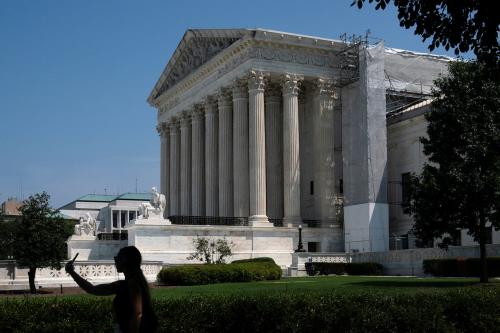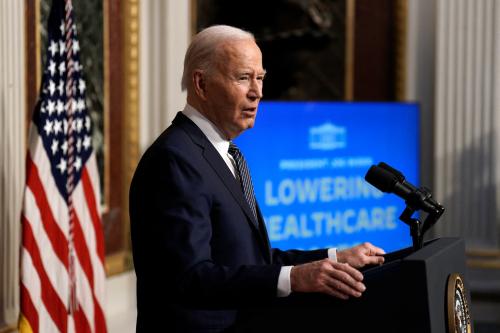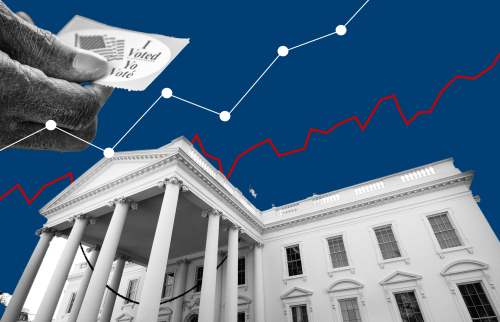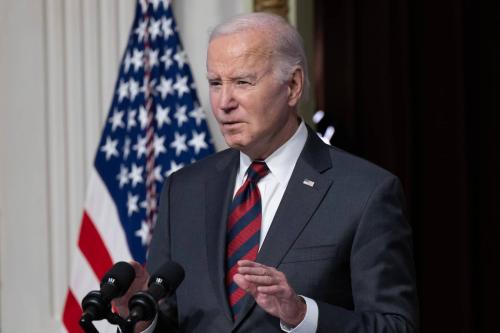Brookings researchers have spent the last year exploring the nuances of one of the most important sub-groups of the electorate, the youth vote, which typically refers to those aged 18 to 29. Our work has highlighted the prospect of this group underperforming in turnout due to low enthusiasm with both candidates and potentially moving toward Trump in higher numbers. But much has changed in the United States over the past two months, especially in the political world. Former President Trump has been convicted of multiple felonies and President Biden has stepped down from the presidential race and immediately endorsed Vice President Harris, who emerged as the Democratic nominee just in time for the Democratic National Convention (DNC).
In this post, we focus our attention on digging deep into the policy attitudes and priorities of this vital sub-group of the electorate in an effort to assess whether the emergence of Vice President Harris as the Democratic nominee will increase turnout among young voters and propel her to victory.
The demographics of the youth vote
As the 2024 election approaches, the influence of young voters, particularly young voters of color, is becoming increasingly pivotal in the presidential race. Young voters under the age of 35 account for roughly 29% of the national electorate. This includes around 8.3 million newly eligible voters for whom this will be the first presidential election in which they can participate. Just this past week, we witnessed young people being represented at the Democratic National Convention in large numbers, with 21% of delegates identifying as people under the age of 36. These raw numbers indicate that this sub-group of the electorate has the potential to impact the upcoming election. However, actualizing that potential will hinge largely on whether younger Americans turn out and if they turn out at high rates, as they have in recent elections.
The youth vote in the United States stands out for its remarkable diversity, with nearly 45% of eligible voters aged 18 to 27 identifying as people of color. This makes the youngest voting bloc the most diverse of any age group in the country. Among this group, 22% identify as Latino, 14% as Black, four percent as multiracial, and another four percent as Asian American.
This diversity significantly influences young voters’ perspectives on key economic and social issues, as many within this group are disproportionately affected by challenges such as student debt, housing affordability, and access to health care. As these issues increasingly shape their voting priorities, the impact of the diverse youth vote could potentially be profound in November.
Despite higher turnout than anticipated in multiple election cycles, apathy among young Americans has suggested that 2024 would yield lower turnout than in 2020. Much of this stems from President Biden’s perceived inability to do the job, especially after his performance during the presidential debate in June 2024, his support of Israel, and his administration’s track record on inflation. Many young Republicans also feel reluctant to vote for former President Trump, describing him as “radicalizing” and “threatening American democracy.”
Additionally, Democrats have been worried about low enthusiasm among young voters due to a host of factors, including low favorability of both Trump and Biden. Whether young people turn out in high numbers and who they vote for will largely depend on how well Trump or Harris persuade young voters that they can improve their economic realities and future opportunities.
Economic challenges are a top priority for young voters
Although abortion and the Israel-Hamas conflict have been the dominant narratives surrounding the youth vote’s policy priorities, the economy is the overwhelming priority of voters under the age of 30. As we discuss below, this is a direct result of young Americans facing tremendous economic challenges. All Americans have had to figure out how to make their incomes stretch further as prices of everyday products have continuously jumped since the 2022 midterm elections, but young Americans are feeling this economic pain to a greater extent than older Americans.
In short, young voters are experiencing a complexity of economic stress. This includes a dramatic rise in the cost of rent and mortgages that has led many to move back in with their parents; a drastic increase in the cost of higher education that has saddled them with college debt; and limited job opportunities, even for those with college degrees. These concerns are more pressing now than they were in 2020, even amid the COVID-19 pandemic. In 2022, inflation reached an average rate of eight percent, peaking at 9.1% in June—the highest level since the early 1980s. This spike in inflation has raised prices by nearly 20% since four years ago—increasing the cost of basic essentials, including food, energy, and rent. Although the rate has fallen to 2.9%, as of July 2024, many young Americans still say prices are too high.
Young adults are experiencing this financial strain differently than older people, as they are relatively new to the job market, trying to establish themselves, and earn significantly less than their older counterparts. Ultimately, this leads to young people having less savings and higher debt, contributing to a cycle of financial instability. In fact, the average credit card debt for Gen Z increased by approximately 14% from 2022 to 2023. Young adults in communities of color also tend to have lower credit scores than those in white communities, compounding cycles of debt.
In addition to general economic stress, housing has emerged as one of the most urgent economic concerns for young voters looking to solidify their independence. Many young Americans fear that the possibility of homeownership—a cornerstone of the “American Dream”—is increasingly out of reach. Rising home prices make the housing market highly discouraging for younger adults interested in buying. Even when adjusted for inflation, home prices have been steadily rising since the 1970s and have skyrocketed since the COVID-19 pandemic, peaking in 2022. Plus, rising mortgage interest rates also make it more challenging for young adults to become homeowners. In 2023, the 30-year fixed mortgage rate reached its highest figure in over 20 years, increasing borrowers’ monthly payments and debt burdens. This increase has come as a shock for adults looking to purchase homes since the rates were set at historic lows during the pandemic to speed up the housing market.
However, median household incomes have remained relatively steady, creating a rising disparity between housing prices and affordability. In 2018, the median household income for Black families was approximately $27,000 less than that of white families, making this issue significantly more urgent for young Black voters. The combination of these factors—a growing home price-to-income ratio, rising home prices, and high mortgage interest rates—creates an economic landscape where the dream of owning a home seems more difficult than ever, and underscores the struggle young voters face in trying to achieve the American Dream.
The housing financial burden is particularly felt by young voters of color, with 39% of Latino voters aged 18 to 29 citing housing costs as their biggest financial hardship. Additionally, 60% of Latinos under 40 who rent their home express a desire to buy one but are hindered by high prices, high mortgage rates, and a lack of savings. Black families also face a significant disparity in housing compared to white families: In 2018, the homeownership rate for Black families was 34.7%, compared to 71.8% for white families.
Practices such as biased mortgage lending and redlining contribute to these disparities in homeownership for people of color. Redlining is defined as a “discriminatory practice that consists of the systematic denial of services such as mortgages, insurance loans, and other financial services to residents of certain areas, based on their race or ethnicity.” These systemic biases have historically targeted minority neighborhoods that typically house people of color, regardless of their income and creditworthiness.
While policies such as the Fair Housing Act of 1968 banned many discriminatory housing practices, the long-lasting effects of redlining are still seen in today’s economy, as evidenced by racial disparities in homeownership. These implications disproportionately affect young voters of color trying to enter the housing market for the first time. The most recent Home Mortgage Disclosure Act (HDMA) data from 2022 shows that Black and Hispanic applicants had notably higher denial rates for home purchase applications than other racial demographics. Data indicates that roughly 16.8% of Black applicants were denied, compared to 12% of Hispanic, 9.6% of Asian, and 6.7% of white applicants. Consequently, this racial discrepancy in approval rates for home purchasing applications contributes to the racial wealth gap as it prevents young adults of color from building wealth through homeownership.
The intersections between housing and other economic factors, especially student loan debt, have a great impact on young voters of color. According to a Latinos and Credit Services Survey, 82% of respondents aged 25 to 39 agree that student loan debt affects their ability to meet basic needs, such as housing, food, child care, health care, and clothing.
The African American community faces similar challenges with student loan debt. Roughly 86% of Black students take out student loans compared to only 68% of white students. Debt accumulates over time and becomes a significant financial burden for young people, which can hinder their ability to purchase a home. This is particularly evident when debt is incurred early, as it can lead to lower credit scores and a reduced capacity to manage payments, making financial stability more challenging to achieve. Student loan forgiveness was an important factor for young voters of color in the 2020 election, and considering the intersection of student loan debt, high cost of housing, and stagnant or slow-growing income, these issues will likely play a large part in influencing young voters’ decision in the upcoming election.
Although President Biden has faced challenges energizing the youth vote, he has attempted to address some of their primary economic concerns and challenges through legislation. During the 2020 presidential election, President Biden prioritized student loan forgiveness, successfully attracting a significant portion of young voters, particularly Black voters, who are disproportionately impacted by student debt. Over the past four years, and after challenges from the Supreme Court, his administration approved $168.5 billion in student debt forgiveness for around 4.8 million Americans. This effort hit a major hurdle this week when SCOTUS denied an emergency request filed by the Biden administration seeking to lift a nationwide injunction imposed by an appeals court. Conversely, former President Trump has also highlighted his record on funding historically Black colleges and universities (HBCUs), pointing to his 2019 signing of a bipartisan bill that secured over $250 million annually for these institutions.
The collective impact of economic stressors has led many young Americans to have low optimism regarding their economic futures and will surely drive how they make voting decisions in November. In fact, according to the Harvard Youth Poll, economic issues, such as rising prices, health care, and housing, rank as young voters’ top three priorities for this election year. This poll had a large sample of young Americans to explore differences across racial groups. Black young adults placed housing as their most pressing concern 68% of the time compared to other issues, the highest of all observed demographics. Inflation was their next highest issue (66%), followed by the cost of health care (58%). For Hispanic young adults, housing and health care were their greatest economic concerns, 60% of the time, making clear that for the two largest racial minority groups, being able to afford housing and health care are dominant economic concerns.
Harris’ economic agenda provides hope for young people
Although Vice President Harris has yet to mention a new student loan forgiveness plan, she recently highlighted an extensive economic proposal centered around reducing costs of everyday items. Her vision for the economy shows her strong commitment to fixing fiscal issues for the working and middle class, which consists largely of young adults. Harris’ proposal, which includes grant support for first-time homebuyers, tax cuts for new families, and a ban on grocery stores overcharging for groceries, is likely to garner support from youth voters who bear the brunt of these economic issues. Harris also aims to construct three million new home units to stabilize the inflation spike experienced recently by the housing market.
Harris’ new economic plan took center stage at the Democratic National Convention, where she and other speakers highlighted critical issues like housing and the rising cost of living. While the primary goal of the convention was to energize all voters for the upcoming election, economic policy—a traditionally challenging area for the Democrats—received significant attention. A major focus was housing, with Harris unveiling her ambitious strategy to “end America’s housing shortage.” Former President Barack Obama echoed this theme, urging action to “build more units and clear away some of the outdated laws and regulations that made it harder to build homes for working people.” Inflation was another key topic at the DNC, with Senator Bob Casey (D-Pa.) referring to it as “greedflation,” a term he used to criticize food corporations for what he described as “extorting families at the checkout counter.” Notably, these issues affect younger people of color more than the general population, so the emphasis on housing and living costs may resonate with this voting bloc and push their support toward the Harris-Walz ticket.
Recent polls suggest that Harris already has substantial support from young voters, but her economic plan could provide the last push Democrats need to secure an advantage this election. The promise of an economic turnaround is likely to drive a higher turnout of youth voters at the polls this season, especially by shifting the view of undecided voters or Independents. The prospect of lower prices and affordable housing provides hope for this young generation—something they have long awaited.









Commentary
How economic concerns are shaping the youth vote in 2024
September 5, 2024